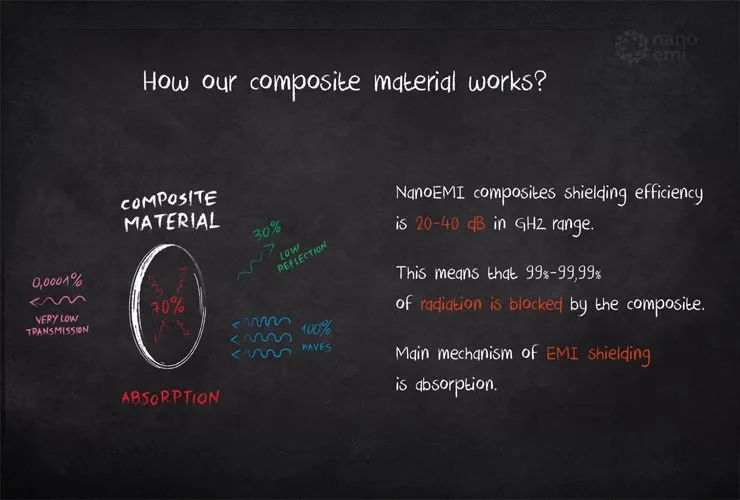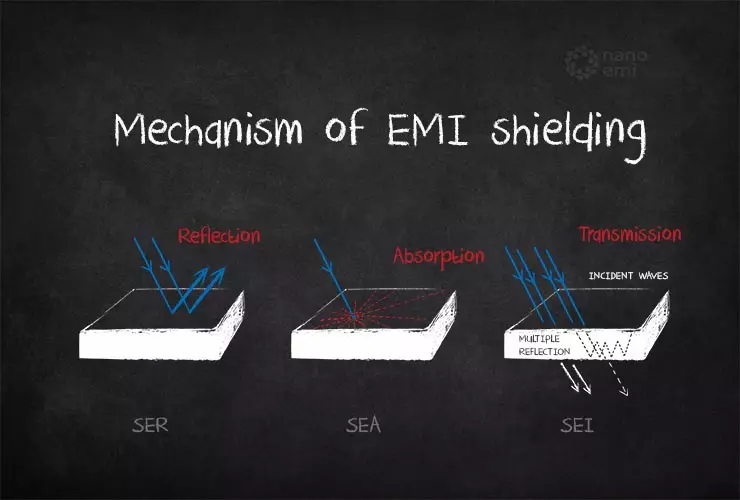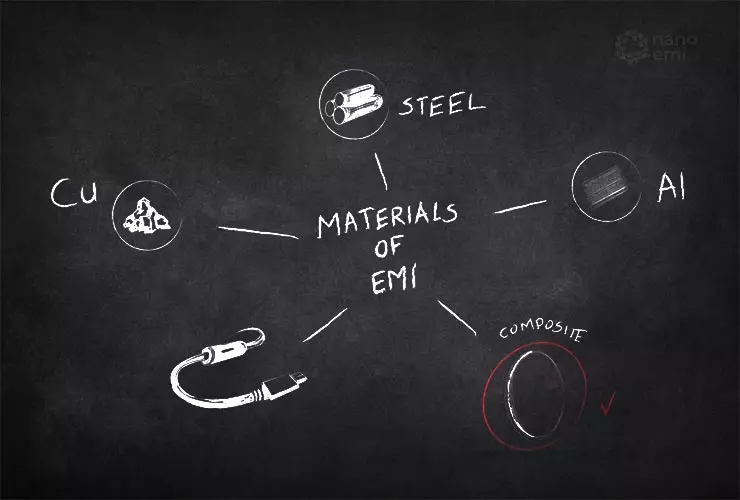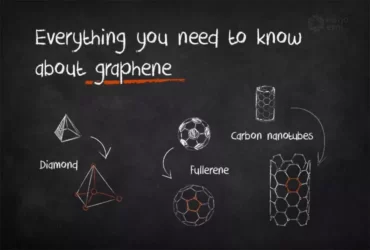Electromagnetic interference – EMI – what it is?

- 1 March 2023
- NanoEMI Admin
- EMI shields, Nanotechnology
Welcome to our article about Electromagnetic Interference (EMI) and what it is. EMI is a phenomenon that occurs when electromagnetic radiation emitted by one device interferes with the operation of another device. This can cause disturbances, noise, or even complete failure of electronic systems, which can have serious consequences in various industries, including medical, military, automotive, and aerospace. In this article, we will explore the basics of EMI, including its sources, effects, and mechanisms, as well as the importance of EMI shielding in securing the proper operation of electronic devices. So, let’s dive in!
In this article you will learn:
- Electromagnetic compatibility – EMC – what it is?
- How electromagnetic interference (EMI) impacts electronic device operation?
- Influence of the electromagnetic interference (EMI) on user safety
- EMC shields (or blockers) – how do they work?
- What are composites (or composite materials)?
- Methods how to block electromagnetic radiation – shielding mechanisms
- Why are composite materials an interesting idea for applications as EMC shields?
Electromagnetic Interference (EMI) is a disturbance that affects an electrical circuit due to either electromagnetic induction or electromagnetic radiation emitted from an external source. This interference can cause a wide range of issues, including signal degradation, data loss, equipment damage, and system malfunctions. EMI can be generated by many sources, including electronic devices, power lines, and even lightning strikes, and can interfere with the proper functioning of electrical and electronic systems.
Interference between two devices
Electromagnetic Interference (EMI) refers to the disturbance that affects an electrical circuit due to either electromagnetic induction or electromagnetic radiation emitted from an external source. This interference can occur between two devices, when one device produces an electrical signal that interferes with the normal operation of another device. This can result in reduced performance, malfunction or even complete failure of the affected device. To prevent EMI, shielding, filtering, and grounding techniques can be used to isolate the interfering signals.
Electromagnetic Interference (EMI) refers to the disturbance in the normal functioning of electronic devices due to the emission of electromagnetic radiation from other devices. Interference between two devices occurs when one device generates electromagnetic radiation that interferes with the functioning of another device. This can occur when two devices are operating in close proximity, or when one device is transmitting energy that is received by another device. Common sources of EMI include electric motors, electronic equipment, power lines and radio-frequency devices. EMI can cause devices to malfunction, result in data loss or corruption, and impact communication systems. To prevent interference between devices, it is important to ensure that electronic devices are properly shielded, and to minimize the distance between the devices.
Examples of electromagnetic interference
Electromagnetic interference (EMI) can occur in many different forms, but some common examples include:
- Radio frequency interference (RFI) – This occurs when radio signals from one device interfere with the normal operation of another device. This can happen with cell phones, Wi-Fi networks, and other wireless devices.
- Electrostatic discharge (ESD) – This is a type of EMI that occurs when an electrical charge is suddenly released from one object to another. This can damage sensitive electronic components.
- Power line interference – This occurs when electrical noise on the power lines affects the performance of electrical equipment.
- Magnetic interference – This occurs when magnetic fields from one device interfere with the normal operation of another device. This can happen with electrical motors, transformers, and other devices that generate magnetic fields.
- Solar flares – Solar flares are huge bursts of energy that are released from the sun and can cause EMI on Earth. This can affect GPS signals, power grids, and other sensitive electronic systems.
These are just a few examples of the many forms of EMI that can occur.
Electromagnetic compatibility - EMC - what it is?
Electromagnetic compatibility (EMC) refers to the ability of electronic devices and systems to work in the same electromagnetic environment without causing any adverse effects on each other. This involves limiting or preventing electromagnetic interference (EMI) and ensuring that the device can withstand exposure to electromagnetic fields without malfunctioning. EMC includes practices and standards for designing, testing, and deploying electronic devices in a manner that ensures their safe and reliable operation in their intended electromagnetic environment.
CE in Europe
CE stands for “Conformité Européene” in French, which means “European Conformity” in English. It is a marking used on products sold within the European Economic Area (EEA) to indicate that the product complies with the essential health and safety requirements set out in the relevant European Union (EU) directives. The CE marking shows that the product has been assessed and meets the required safety, health, and environmental protection standards, and can be freely traded within the EEA. It is also a symbol of the manufacturer’s declaration that the product complies with the applicable EU regulations, and it is the responsibility of the manufacturer to ensure ongoing compliance with these regulations.
EMC regulations all over the world
EMC (Electromagnetic Compatibility) regulations vary from country to country, but the basic principles are the same. The goal of these regulations is to ensure that electronic devices do not interfere with each other, and that they are protected from electromagnetic interference. Some countries have mandatory EMC regulations, while others have voluntary standards. Some countries, like the European Union, have EMC regulations specific to their region. Other countries, such as the United States, have a federal EMC regulatory framework. In Asia, the regulations are diverse and often country-specific. It is important for manufacturers to be aware of the EMC regulations in their specific market, and to comply with these regulations to ensure that their products are safe and compatible with other electronic devices.
How electromagnetic interference (EMI) impacts electronic device operation?
Electromagnetic interference (EMI) can adversely affect the operation of electronic devices. It can cause signals to become distorted, leading to errors in data transmission and processing. EMI can also cause a device to malfunction, such as causing it to shut down or produce incorrect results. In extreme cases, EMI can even cause permanent damage to electronic devices. To minimize the effects of EMI, electronic devices are often designed with shields and filters to reduce the amount of interfering signals that reach the sensitive components of the device. Additionally, regulatory agencies like the FCC in the US and the CE in Europe have established standards for EMI emissions to help ensure that electronic devices do not generate excessive amounts of EMI.
Standards for Electromagnetic Interference (EMI) emissions are guidelines and regulations established by international and national organizations to control the amount of electromagnetic energy that electronic devices can emit. These standards help to minimize the risk of EMI affecting the operation of other electronic devices and equipment, particularly in sensitive environments such as medical facilities, aviation, and military applications. The standards specify maximum levels of EMI emissions for different frequency ranges, and set requirements for the design, testing, and labeling of electronic devices to ensure that they meet these levels. By following these standards, manufacturers and suppliers can help to ensure that their products are compatible with other electronic devices and do not cause harmful interference.
Influence of the electromagnetic interference (EMI) on user safety
Electromagnetic interference (EMI) can negatively impact user safety by potentially disrupting the operation of electronic devices and causing them to malfunction. This can result in equipment failure, which can pose a risk to the user or those nearby. For example, medical devices may not function correctly and threaten the patient’s health, or electrical appliances may pose a fire hazard. To minimize these risks, strict standards and regulations are in place to control the levels of EMI emissions from electronic devices, ensuring that they are safe to use.
Importance of the interaction of electromagnetic radiation with human tissue
The interaction of electromagnetic radiation with human tissue is important because it can have potential health effects. Electromagnetic radiation can penetrate human tissue to different depths depending on its frequency and intensity, and it can affect cells, tissues, and organs. The impact of electromagnetic radiation on human health depends on the frequency, intensity, duration, and type of exposure. Excessive exposure to high-frequency electromagnetic radiation has been linked to various health problems, including headaches, fatigue, and skin irritation, while long-term exposure to low-frequency electromagnetic radiation has been associated with an increased risk of cancer, developmental problems, and other health issues. Therefore, it is important to regulate and monitor the levels of electromagnetic radiation in our environment to ensure that they are within safe limits and do not endanger human health.
Legal regulations to secure user safety
Legal regulations for user safety are designed to ensure that products and devices are safe for people to use. These regulations vary from country to country, but common examples include the European Union’s CE marking, the United States’ FDA and FCC regulations, and international standards such as IEC and ISO. These regulations cover a wide range of products, including medical devices, household appliances, and electronic equipment, and typically require that products meet specific safety requirements, such as electrical safety, electromagnetic compatibility, and protection against radiation. By ensuring that products meet these standards, regulators aim to protect users from harm and promote safe and reliable products.
CE mark in Europe and electromagnetic compatibility
CE mark in Europe is a mandatory conformity mark for certain products that are sold in the European Economic Area (EEA). The CE mark indicates that a product meets the essential requirements of the relevant European Union (EU) health, safety, and environmental protection legislation. The CE mark also ensures that the product is electromagnetic compatible (EMC) and meets the EMC standards set by the EU. These standards are designed to minimize the impact of electromagnetic interference (EMI) on electronic devices and to ensure that electronic devices do not emit harmful levels of EMI. The CE mark is a key tool in ensuring user safety and the proper functioning of electronic devices in Europe.
EMC shields (or blockers) - how do they work?
EMC shields, also known as electromagnetic interference (EMI) blockers, work by reducing the amount of electromagnetic radiation that passes through them. This can be accomplished through the use of conductive materials, such as metal, which effectively block the electromagnetic radiation from passing through. Other materials, such as metalized plastic, may be used to create a Faraday cage that reflects the radiation back towards its source. The effectiveness of the shield depends on its design, the frequency of the electromagnetic radiation, and the distance between the shield and the source. The use of EMC shields helps to ensure that electronic devices are not impacted by electromagnetic interference and that they operate correctly and safely.
What are composites (or composite materials)?

EMC shields, also known as electromagnetic interference (EMI) blockers, work by reducing the amount of electromagnetic radiation that passes through them. This can be accomplished through the use of conductive materials, such as metal, which effectively block the electromagnetic radiation from passing through. Other materials, such as metalized plastic, may be used to create a Faraday cage that reflects the radiation back towards its source. The effectiveness of the shield depends on its design, the frequency of the electromagnetic radiation, and the distance between the shield and the source. The use of EMC shields helps to ensure that electronic devices are not impacted by electromagnetic interference and that they operate correctly and safely.
Composites can be divided into several categories on the market, including:
- Polymer Matrix Composites (PMC): These composites are made of a polymer matrix and reinforcement materials such as fiberglass, carbon fiber, or graphene.
- Metal Matrix Composites (MMC): These composites are made of a metal matrix and reinforcement materials such as particulates, whiskers or continuous fibres.
- Ceramic Matrix Composites (CMC): These composites are made of a ceramic matrix and reinforcement materials such as ceramics, carbides, or intermetallics.
- Natural Fiber Composites: These composites use natural fibers such as bamboo, hemp, or flax as the reinforcement material in a polymer matrix.
- Hybrid Composites: These composites use a combination of reinforcement materials such as fiberglass, carbon fiber, and natural fibers in a polymer matrix.
Each type of composite has different properties and applications, making them suitable for different industries and products.
Methods how to block electromagnetic radiation - shielding mechanisms

There are several methods to block electromagnetic radiation or create shielding mechanisms. Some of the most common methods include:
Conductive Shielding:
Conductive materials like metals are used to form a Faraday cage that redirects electromagnetic waves and blocks them from passing through.
Conductive shielding is a mechanism used to block electromagnetic radiation by using a conductive material to direct the flow of electric charges and thereby prevent the radiation from passing through. The material used is usually a metal, such as aluminum or copper, which has high electrical conductivity. The conductive material is used to create a closed Faraday cage around the device or area that needs to be protected, thereby blocking any incoming or outgoing electromagnetic waves. The conductive shielding can be further improved by using a combination of conductive materials, such as metal-coated fabrics, metal-coated foams, or metal mesh, to form a multi-layered shield. This multi-layered approach provides better shielding effectiveness and reduces the risk of electromagnetic interference to a minimum.
Magnetic Shielding:
Magnetic materials, such as mu-metal, are used to create a magnetic field that opposes the magnetic component of electromagnetic waves and reduces their intensity.
Magnetic shielding is a mechanism of blocking electromagnetic radiation (EMI) by using magnetic fields to divert the EM energy around a protected area. This method works by using magnetic materials, such as mu-metal, to surround the protected area and create a magnetic shield. The magnetic shield redirects the magnetic fields and prevents them from entering the protected area, thus providing protection against EMI. Magnetic shielding is most effective against low-frequency electromagnetic radiation, such as power-frequency and intermediate-frequency fields, and is commonly used in applications where electrical equipment is sensitive to magnetic interference.
Absorbing Shielding:
Absorbing materials, such as carbon-loaded rubbers, are used to absorb electromagnetic energy and prevent it from being reflected back into the environment.
Grounding:
Grounding is a simple but effective way to reduce electromagnetic interference by connecting the device to a conductive material that is in direct contact with the ground.
Grounding shielding is a technique that uses a conductive path to redirect electromagnetic energy away from the protected equipment. The conductive path is usually connected to the ground, hence the name grounding. By providing a low-impedance path for the electromagnetic energy to flow through, grounding shielding helps to prevent it from affecting sensitive electronics or other equipment that may be nearby. Grounding shielding is often used in combination with other shielding methods, such as conductive shielding or magnetic shielding, to provide a more comprehensive solution for reducing the effects of electromagnetic interference (EMI).
Chokes:
Chokes are inductors that are used to restrict the flow of electromagnetic energy and prevent it from escaping from the device.
Chokes shielding is a method of blocking electromagnetic interference (EMI) by using magnetic materials that are wound into a coil shape. The coil is designed to create a high impedance to the passage of AC electrical current in a specific frequency range. When an electromagnetic field passes through the coil, the magnetic material generates a current that opposes the field, effectively blocking or reducing the level of the EMI. Chokes shielding is often used in electronic devices, power supplies, and cables to prevent EMI from affecting their performance and operation. The chokes used for shielding can be in the form of ferrite beads, common mode chokes, or toroidal the inductors.
Filters:
Filters are passive components that are used to restrict the frequency range of electromagnetic energy and prevent it from affecting other devices.
Filter shielding is a technique used to block electromagnetic interference (EMI) by filtering out unwanted signals and allowing only desired signals to pass through. This is achieved through the use of filters, which are passive components designed to eliminate certain frequencies or signal ranges. Filters can be designed in various forms, including low-pass, high-pass, band-pass, and band-stop filters, and can be installed in different locations within an electronic system. In EMI shielding, filters are used to prevent unwanted interference from affecting the performance of electronic devices and to protect sensitive components from damage caused by high-frequency signals. Filters can also be used to suppress interference in the frequency range emitted by the device, which reduces the amount of EMI generated by the device and reduces the risk of interference with other electronic devices.
Composite Materials:
Composite materials made of a combination of conductive, magnetic, and absorbing materials can be designed to provide an effective shield against electromagnetic radiation.
Composite materials shielding is a method of electromagnetic interference (EMI) protection that involves combining multiple materials with different electrical and magnetic properties to create a composite material. This material is designed to provide efficient EMI shielding by offering a combination of reflection, absorption, and conductive shielding mechanisms. The different materials are carefully selected to work together and are layered to create a barrier that effectively blocks electromagnetic radiation. Composite materials offer the advantage of being customizable, allowing designers to tailor the material to specific EMI protection requirements, including frequency range, shielding effectiveness, and thickness. Additionally, composite materials can be manufactured to meet specific requirements, making them suitable for use in a wide range of applications, from electronic devices to military and aerospace systems.
Absorption
Absorbing shielding mechanism involves using materials that can absorb electromagnetic radiation and convert it for instance into heat. This type of shielding is typically used for high frequency emissions that are difficult to reflect. The material used for absorbing shielding is typically made up of foam, sponge, carbon fiber or a combination of materials. The key idea behind absorbing shielding is that the material should have a high electrical conductivity, high dielectric constant and high dielectric loss. This combination allows the material to absorb the energy from the electromagnetic radiation and convert it into heat. This type of shielding is commonly used in microwave absorbing materials, electromagnetic absorbing coatings, and radio-frequency absorbing composites.
Reflection
Reflection shielding is a mechanism of blocking electromagnetic radiation by reflecting it away from a protected area. It works by placing a reflective material, such as metal, in close proximity to the electronic device or component being protected. The metal surface acts as a mirror, reflecting incoming electromagnetic waves away from the protected area. This method is effective in reducing the amount of electromagnetic radiation that reaches the protected area, thereby reducing its impact on the electronic device or component. The effectiveness of reflection shielding depends on the type of metal used, its thickness, and the frequency of the electromagnetic radiation being shielded.
Scattering
Scattering Shielding is a mechanism used to block electromagnetic radiation by creating a physical barrier that scatters the radiation in multiple directions, reducing its strength and minimizing the amount that reaches the protected device. This is usually accomplished by using a material that has irregular surfaces or roughness, causing the electromagnetic waves to be redirected and absorbed by the surface, thereby reducing its impact on electronic devices. Scattering Shielding is commonly used in combination with other shielding mechanisms, such as Absorbing Shielding or Reflection Shielding, to provide a more comprehensive and effective solution.
Why are composite materials an interesting idea for applications as EMC shields?

Composite materials are an interesting idea for applications as EMC shields because they offer unique advantages over traditional materials such as metals and plastics. They have the ability to combine multiple properties, such as conductivity, permeability, and dielectric constant, into one material. This allows for greater design flexibility and optimized shielding performance. Additionally, composite materials are often lighter and more cost-effective than traditional shielding materials, making them an attractive option for a variety of applications. They can also be easily molded and shaped to fit the specific requirements of the device, making them ideal for use in compact electronic devices where space is limited.
Are you ready to embrace the cutting edge of graphene innovation?
Look no further than Nanoemi’s online store, your gateway to the incredible world of graphene.
Don’t miss out on the chance to be at the forefront of innovation. Explore Nanoemi’s collection of premium graphene products and take the first step towards a future powered by limitless potential.
Categories
Tags
Newsletter
Get regular updates on graphene science news, graphene products, composites
and 2D materials








